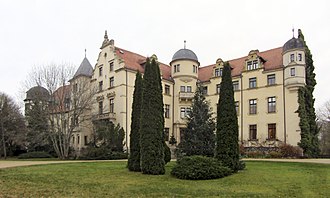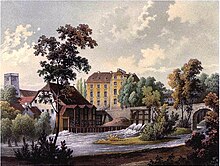Neugattersleben Castle
The Neugattersleben castle arose from a significant medieval castle complex in Neugattersleben on the banks of the Bode between Halle and Magdeburg in today's Saxony-Anhalt . It was owned by the von Alvensleben family from 1573 to 1945 .
Strategic location and early history
At the junction of Heerstraße from Magdeburg to Halle (Saale) and Leipzig over the Bode flowing down from the Harz Mountains, the age-gray Neugattersleben Castle, surrounded by watchtowers, stands in front of wide park backgrounds. Since the Middle Ages, all armies of Europe that fought on the battlefields of Central Germany have flooded back and forth over the weathered arched bridges that span the river arms . Here on the Bode, shortly before it flows into the Saale , the Archdiocese of Magdeburg and the Principality of Anhalt-Bernburg once collided. From 1815 Neugattersleben belonged to the Prussian province of Saxony .
The name probably refers to the older Gatersleben castle and the family named after them, which belonged to the Bishop of Halberstadt as early as 1179. Since 1243, a family named after the Neugattersleber Castle owned the castle as an archbishop's fief. In the middle of the 14th century , the Magdeburg magistrate acquired the basic rights. In 1549 Emperor Charles V imposed an imperial ban on Magdeburg - because of his conduct in the Schmalkaldic War - and in 1550 enfeoffed the Counts of Mansfeld with Neugattersleben, which, however, returned to the city in 1563. As it was heavily in debt, the magistrate was forced to sell.
The Alvensleben period
In 1573, together with Privy Councilor Ludolf X. von Alvensleben, Alvensleben acquired the castle and dominion at Schloss Hundisburg . Until 1809, the town hall there had to be re-loaned after the death of the respective senior of the family and the mayor of the old town of Magdeburg. From 1573 until the 19th century, Magdeburg, the urbs Parthenopaea, as it is called in documents, led the Alvensleben heraldic rose in the divided heraldic shields as liege mistress.
The new owner, Ludolf X. von Alvensleben, built the north-west wing of the palace, the castle chapel and a six-aisle watermill . His successor continued building the palace from 1597–1609. Divided in 1619, the castle and the lordship were divided into an "old" and a "new side" until 1796. With Gebhard XXIII. von Alvensleben the Neugatterslebener Alvensleben acquired important pledges in the Mark and Lausitz: 1613–1625 the lordships of Beeskow and Storkow and 1625–1627 Cottbus and Peitz . The Alvensleben's hope of transforming these important dominions into hereditary property was destroyed by the Thirty Years' War , which left the descendants of Neugattersleben impoverished.
From the rubble left by the war, arose under Gebhard XXV. von Alvensleben the residential buildings 1657–1665, enriched by a baroque chapel on the upper floor, a multilingual library and the once famous collection of 250 portraits of outstanding personalities, which was spread over three halls. In the 18th century there were plans to build a separate gallery building. A Gothic vault and a stucco ceiling with religious representations in the castle are still reminiscent of the two former castle chapels.
The Minister Johann Friedrich II. Von Alvensleben , creator of the baroque palace and park in Hundisburg , also expanded the Neugattersleben gardens. Their renaissance-like division suggests that the beginnings go back to the 16th century. Every generation changes something in gardens. The two generations of Anglo-Hanoverian ministers who followed Johann Friedrich, Rudolf Anton von Alvensleben (1688–1737) and Johann Friedrich Karl von Alvensleben (1714–1795) also enriched Neugattersleben with collections; they cared for and beautified the park with its arcades, sculptures and canals. However, following British models, they began to transform it into a l'angloise from 1758, i.e. early on . The iconological program of the once numerous statues on the garden parterres is well known.
In 1796 the large properties of the house were divided among six brothers. They established new lines that acquired property as far as Silesia, East Prussia and, after 1900, in other parts of the world. In 1798–1805 the extensive castle was completely rebuilt. The royal couple Friedrich Wilhelm III. and Luise were the first guests in the renovated castle, shortly before the Napoleonic wars almost brought this house down too.
The middle of the century under Ludwig von Alvensleben (1805–1869) was characterized by economic growth: the mining of lignite, potash, limestone and industrial plants corresponded to the progress in agricultural technology. Since 1573, Neugattersleben in particular has been richly endowed with foundations for public welfare. His son Werner-Alvo von Alvensleben (1840–1929) - entrepreneurially gifted - successfully continued economic activities. He was also the castle captain of Quedlinburg and one of the most famous four-in-hand drivers before 1914. He rebuilt the castle buildings in a romanticizing way (1870 and 1883–1884) and, being creatively gifted, expanded the park.
His successor, Count Bodo von Alvensleben , lord of the castle until 1945, exerted far-reaching influence in times of ferment and decline - including as president of the German gentlemen 's club . His brother Werner (1875–1947) came into conflict with the regime and was sentenced shortly before the end of the war in 1945 by the People's Court , chaired by Freisler . A memorable event: in 1936, the Bishop of Münster and later Cardinal Clemens August Graf von Galen , the head of the church-wide resistance to the National Socialist government, married a daughter of this house at the castle, which had been represented by strong personalities over the centuries.
Old view and reconstruction image
Up until the Thirty Years' War, the upper castle had pointed towers and half-timbered structures. After 1657 it was transformed into an early baroque building with richly decorated gables, dwarf houses and two stair towers with high, multiple broken onion hoods, as we can see in our picture. From 1798, towers and decorative shapes were removed. The three storeys were given regular rows of windows in the style of late baroque classicism, which remained when the castle regained towers, gables and bay windows in 1883, albeit in a different form. The age of the buildings is not easy to guess due to the somewhat confusing development.
For the present view, the view from the north was chosen in order to bring the castle and Bode arms into the foreground, especially since a contemporary engraving also shows the interesting south front. Both pictures show the state of the 18th century, which is not difficult to compare with today's, although individual parts of the building are missing and the baroque garden has been changed. Between the castle and the mill, the medieval bridge crosses the ramified courses of the river today as it once did. The small island by the castle, called the Schiffchen , used to serve as a bulwark . In the "Vogelherd" (top right) there was a round hedge labyrinth.
Inside the house (1945), around the entrance hall, was the older castle chapel with Gothic vaults and, among other living rooms, the library and the Black Eagle Chamber , so named after the portraits of the family members who were awarded the Order of the Black Eagle . On the main floor there were ballrooms and the imperial rooms with stucco ceilings from the 17th century, which were once intended for visits by monarchs.
The church , mausoleum and Kaiser Wilhelm tower, rich in tombs , look down from the hills onto the Bodetal, castle and park meadows. The tower keeps the memory of visits from Kaiser Wilhelm II alive, who often announced himself to hunt and here alone brought down more than five thousand head of game. In the church is the sarcophagus designed, donated and inaugurated by the emperor himself for the castle mistress Anna von Veltheim (d. 1897), on which she is depicted resting under a canopy.
The time after 1945
After the expropriation by the land reform in 1945, the castle first served as a higher agricultural school, then as a technical school for agriculture, then as an institute for agronomy and from 1960 to 1992 as an agricultural engineering school for seed management. Only a small part of the property was settled and managed as VEG. In 1992 Theopra Bildungsgesellschaft mbH took over the castle, initially as a lease and in 1997 as ownership. Since 1999 a complete renovation and restoration has been carried out by the new owner Klaas Hübner .
literature
- Wilhelm Kamlah: The history of Hohendorf, Neugattersleben, Löbnitz with a chronicle . Eisleben 1907, OCLC 247251920 .
- Ernst Krause: Memories of Neugattersleben . Unpublished manuscript (219 pages). Hall 1935.
- Udo von Alvensleben-Wittenmoor : Alvensleben castles and country houses . Dortmund 1960, DNB 990104818 .
- Busso von Alvensleben: Neugattersleben . (= Castles and gardens in Saxony-Anhalt). Deutsche Gesellschaft eV, Berlin 2010, ISBN 978-3-941675-25-4 .
Web links
- Material on Neugattersleben Castle in the Duncker Collection of the Central and State Library Berlin (PDF; 295 kB)
- Neugattersleben community
- Castle Neugattersleben on the website of the family v. Alvensleben
Coordinates: 51 ° 51 ′ 4.7 " N , 11 ° 42 ′ 17.9" E




